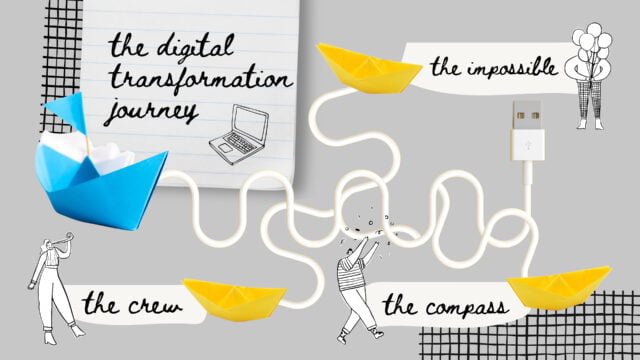Ahoy, adventure! Young people and the European digital transformation journey
Year of production: 2021
You either hate it or you love it, but digital transformation is here to stay.
Digital technologies continue to affect the way we exchange ideas, co-create knowledge, and nurture our interactions with other people. From using social media to advocating against discrimination, to the co-creation of digital simulation aiming to tackle the climate crisis -– young people are both transforming and being transformed by digital technologies.
However, as ‘the digital transformation ship’ continues to sail, how do we know we’re headed in the right direction? Are young people at its steering wheel or merely its passive passengers? How can we support young people to make the most of the digital transformation journey? The purpose of this article is to explore these questions. Embarking on our youth-centred digital transformation journey, I propose three areas for consideration: the journey, the crew, and the impossible.

The compass: navigating the journey
There is no clear map for digital transformation. At present, it seems impossible to indicate where the European digital transformation is headed – and how to get there. Digital transformation is a complex, multidimensional, and also often unpredictable process. Digital changes may take place simultaneously in economic, social, and cultural areas of young people’s lives. Considering the diverse range of technological changes, it seems impossible to predict what the next stage of the digital transformation will be. In which case, how are we meant to prepare ourselves for our digital transformation journey if we’re headed into the unknown?
One of the solutions may be to empower young people to cultivate an agile mindset to experience and to navigate and respond to their possible paths. To do this, we may need our digital transformation compass. Our compass would not show us a fixed digital transformation path, but a range of directions we can take. To navigate the different directions, it would provide young people with the skills (e.g. skills related to Media, Information, and Critical Thinking, creativity, resilience) and tools (e.g. digital devices, reliable internet connection). Thus, our digital transformation compass would not be giving young people the exact directions, but rather supporting them in the critical exploration of the emerging digital transformation pathways. For inspiration, you may want to explore European resources on digital youth work and/or smart youth work.
The crew: are we all on board yet?
All young people should be supported to be on board during the digital transformation journey. From co-designing future technological solutions to co-managing their impact on society – meaningful youth participation is crucial in moving digital transformation forwards in a youth-centric and sustainable manner. However, to date, most digital transformation processes have been primarily corporate-led, and externally governed – and thus also imposed on young people. Apart from singular examples of young people’s participation in digital transformation, their voices have largely been left out of debates. It can be said that, as the digital transformation ship is sailing into the unknown, young people have limited agency and are largely framed as passive passengers (e.g., app users not app creators). In addition to this, the existing digital inequalities in Europe also limit young people’s participation in digital transformation even further.
On the flip side, incredible things can and do happen when young people are on board and take proactive roles in shaping digital transformation. Young people’s experiences, their unique point of view and expertise should be utilised and celebrated when looking into the future. Existing youth-centred digital initiatives have proven that – if provided with the right support – young people can provide a significant contribution to digital transformation. In many cases, youth participation in digital transformation has gone beyond focusing on individual topics such as online safety or coding. For instance, young people involved in the Youth Internet Governance Forum (YIGF) continue to provide strategic contributions to the future of digital transformation. Another example includes young people co-designing an online platform aiming to encourage positive approaches to youth wellbeing. As the ‘digital transformation ship’ is moving forward, we need all young people on board so that they can channel their ideas and expertise into the creation of innovative and sustainable digital solutions.
The impossible: embracing the adventure
Travelling into the unknown can be risky, but it can also lead to exciting discoveries. While there is loads to worry about when it comes to digital transformation (e.g. online safety, digital rights), we should not forget about its empowering and innovative potential. Digital transformation may offer new ways to co-create innovative solutions to enhance non-formal youth projects, reinvigorate youth participation, and facilitate intercultural exchange. If carried out in an inclusive way, digital transformation can lead to the co-creation of a more just and accessible way for marginalised young people (e.g., young people with disabilities). Existing projects have proven that youth participation in digital transformation projects can lead to innovative cutting-edge solutions. Young people from Lithuania utilising AI to monitor fields and crop performance; young people in Austria experimenting with Augmented Reality (AR) to create innovative solutions for tourism and heritage; young people in Estonia setting up leadership and entrepreneurship accelerators for teenage girls – these are just some of the practical examples of youth-led innovation. Thus, to move forwards, it may be useful to approach the digital transformation
adventure with an open-mind and a pinch of hope that if we try hard enough – we can steer ‘the digital transformation ship’ in the right direction.
What are some of the existing resources that could help youth workers and young people to better understand some of the challenges and opportunities related to digital transformation? First, you may want to take a look at Developing Digital Youth Work, an EU publication exploring some of the risks and opportunities of digitalisation for youth, youth work and youth policy. Then there is the EU’s Digital Education Plan (2021-2027), a European Union (EU) policy initiative to support sustainable and effective education in the digital age. Practical examples of digital youth transformation topics and good practice can be found in the SALTO Participation & Information Resource Centre’s (SALTO PI’s) Flagship Projects Collection as well as the European digital youth work platform.
Feel like you still want to learn more about digital transformation in the European youth field? We’ve got some good news – digital transformation has become a new priority in the EU Youth Programmes (Erasmus+ and European Solidarity Corps). At SALTO PI, we’re currently developing a new topic for the Participation Resource Pool regarding all things related to digital transformation in the European youth sector and EU Youth Programmes. The platform will offer useful and inspirational resources, so stay tuned. In the meantime, let’s get the digital transformation ship moving forwards.





